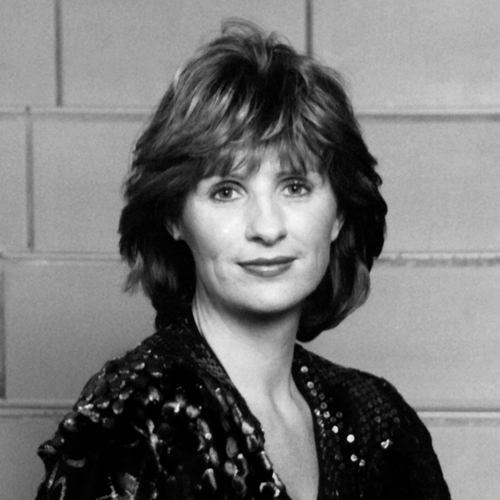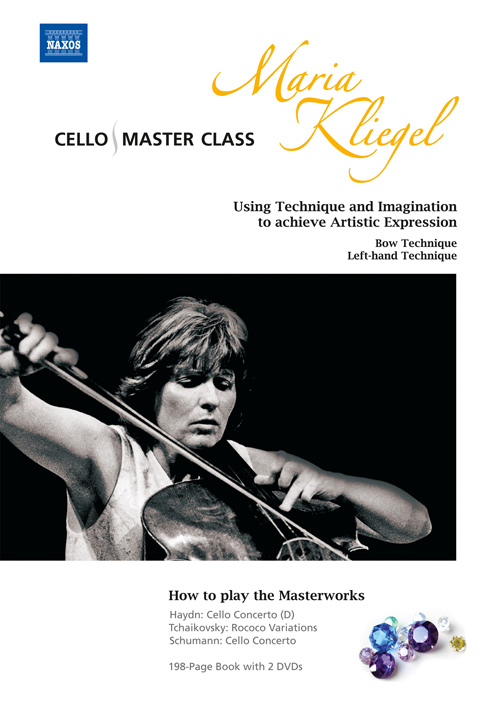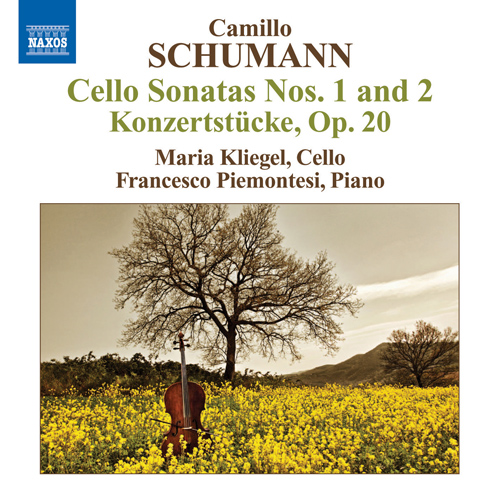Queen of the Cello – Maria Kliegel Interviewed by Jeremy Siepmann
January 18, 2011
Photo: Karl Scheuring
Proclaimed by Mstislav Rostropovich as ‘the best cellist I have heard since Jacqueline du Pré’, Maria Kliegel is a household name amongst record buyers around the world. Her repertoire ranges in time from Bach to the present, and her recording of Alfred Schnittke’s Cello Concerto has been hailed by the composer as definitive. Serious and exuberant, reflective and spontaneous, both commanding and daring, she lives life, and music, to the full. Her palpable identity with the cello is so intimate and compelling that it comes almost as a shock to learn that it was not, in fact, her first instrument.
‘I actually started with the flute. At six I began learning the piano, and it wasn’t until I was 10 that I first encountered a cello. And I was hooked from the start. The first time I passed the bow across the strings, the resonance of the sound just enraptured me. It was fantastic. I can’t imagine I’d have felt the same about the flute or the oboe or the violin. Everything about the cello is so natural, right from the beginning. Unlike the violin, there’s nothing complicated about the way you hold it. Well, more than hold it; you embrace it. The cello is like a part of my body—not an instrument that I play on, but an extension of myself.’
By the time she was 15 or 16, it was clear to Maria that music was going to be her life. But did she always envisage a career as a soloist? “Absolutely not at all! That wasn’t ever something I was aiming at; it just sort of happened. I loved the instrument, I loved the repertoire, I loved the LPs I had—mostly of Oistrakh, Heifetz, Richter and Rostropovich. These were my heroes, my windows on the world. Especially Rostropovich, of course. I was utterly bowled over by his sound. All I wanted to do was to practice so that I could sound like that. That was really my only ambition.’
In time she would meet the great man and incur a lifelong debt. But first came another. At 19, she became a pupil of the great Hungarian-born cellist János Starker, who changed her life. Feared as much as famed, he intimidated many, and terrified more. Kliegel held her ground, but the learning curve was steep. ‘When I first played for him, he ripped me to shreds. He saw at once what was wrong with me. I could play the cello but didn’t know what I was doing. And he started to explain to me in great detail how things work. “OK,” he said. “I’ve torn you apart into a thousand pieces but now I’m going to put you together again.” Bit by bit, with little successes every day, it was like climbing Mount Everest, step-by-step. But as I say, the next day was always better than the day before—and from the beginning I could see how it was working. I could see exactly what he meant, and after the initial shock, I felt quite indescribably happy.’
It was in 1977 that she first met and got to know her first idol, Rostropovich—at a month-long course of masterclasses. ‘There I could watch him at work every day, for four weeks, eight hours a day. It was incredible. The way he was living music, drinking music, being music—he seemed like music incarnate. Interestingly, the instrument was never the central focus of his attention. This was always the music. By that time, of course, I had a very good technical basis, thanks to Starker, and Rostropovich now opened up my ears, my eyes, my heart, my soul, everything. Yet, strangely, he seemed totally uninterested in helping his students. If anyone asked for help with a tricky passage or whatever, asked his advice about bowing or fingering, he would just dismiss them out of hand. He was there to give his opinion, say what he wanted to say about the music, about the composers, showing how you can play like this or like that, exploring the score—and this was always fascinating. But even if somebody got his message, if someone could really understand him, and communicate this in performance, he just wasn’t interested.
‘This was completely different from Starker, who was always interested in helping people, within their own frame. No matter who the student was, Starker was always interested in helping them to develop. He was deeply interested in people, even after they had studied with him. One thing, however, that he and Rostropovich had in common was that they took pupils of all kinds, not just potential hotshots. But Starker could also be rather limiting, in a way. He had certain principles about technique (how to guide your fingers, how to train specific muscles and all that) and sometimes, maybe, it was too much of a priority for him. It actually hindered me, while I was his pupil, in trying to find my own solutions. His complete mastery of the instrument could be intimidating. How could I, a little 19-year-old nothing, dare to question him, argue with him, try something other than what he suggested? I just followed his path, without thinking much about it—I couldn’t help it.
‘For Rostropovich, the most important thing was to play with absolute conviction, to convince audiences, to communicate the essence of the music. And strangely, technique didn’t seem to interest him. If you could get the right result, he didn’t care if you did with your toes. It was Rostropovich who kissed me awake, like the Princess in the fairytale, telling me “Dare to do what you want, follow your own impulse, your own path. Don’t always be thinking about what others may be thinking. Find your own way. Find it, and follow it.” The atmosphere there was terrific. Everyone felt relaxed and comfortable and able to play their best. With Starker it was different. But he was, and is, a great, great teacher.’
Particularly given Kliegel’s own mastery, and her characterisation of the cello as an extension of her body, I was curious to know about her favoured instrument. ‘I have two, actually. One of them I teach on, an excellent cello modelled on a Goffriller. The other, which I’ve been using for concerts and recordings over the last couple of years, was made by Carlo Tononi in 1730. For 15 years previously, I’d played on the Stradivarius once owned by Maurice Gendron, which was offered to me by his widow. I know all string players crave a Strad, and of course there were many wonderful things about this instrument, but when I discovered the Tononi it was like having a new lover! It still is. The Strad was much harder to play, it was quite moody, actually, in fact it was challenging in many ways. The Tononi is easier to play, it responds more quickly, has so many ‘voices’, and I get so many ideas from playing it—fingerings, phrases, changing colours and so on—that I wouldn’t have got on the Strad.’
As her playing reveals, Kliegel is a highly sentient musician who thrives on ideas, while embracing the wisdom of instinct. The marriage of intellect and the imagination is central to her music-making. Small wonder, then, that she is a dedicated, resourceful and liberating teacher, and for the last 25 years has been a professor at the Cologne Hochschule für Musik—a position she relishes. ‘It’s really fantastic to help young people, to educate them, to help them find their own personalities. In a way I feel I’m accompanying them, letting them benefit from my greater knowledge, and exploring with them their own personalities: what they want to do with their lives, what are their attitudes, their strengths, their weaknesses, how can I help them to find their own way in life. This is a very rewarding and interesting task—it’s not just a case of four strings and a bow. You have to be verbally articulate not just musically articulate. I don’t want to do with them what Starker did with me, which was to put me in a kind of plaster cast, purposely inhibiting my individual development at that stage, although he always told me that I could follow my own path freely when our studies were over. I want to give the room to my students that I missed myself back then. I want them to always understand why I do what I do, and to understand why they’re doing what they do. I want them to realise that technique and expression are indivisible. And of course I want them to understand what a fantastic privilege and joy it is to be a musician!’
Kliegel’s own understanding of this is abundantly evident in her near-40 recordings for Naxos. In the recording studio, as in the concert hall, she is in her element. ‘I always enjoy recording. And the teams I’ve worked with at Naxos have been just wonderful. The atmosphere in the studio is always so alive - and positive. We’re all partners in the performance. I don’t see my colleagues when I play, but I know they’re there, and I play to them, just as I would in a concert. There’s never any feeling of frustration. And the producers never interfere. For instance, if my intonation is a little off in some passage, they know I know, and they don’t stop me, as some producers might. They know we can attend to that later. And they know that I like to record in big takes—whole movements at a time wherever possible. I hate the idea of making a kind of patchwork performance.’
Her latest, and in many ways her most ambitious, project may not be precisely a patchwork but it required a high degree of meticulous coordination. And in it her love of music, performance and teaching finds its most integrated expression to date. ‘It’s really a kind of a lifetime testament: a book about cello technique with two accompanying DVDs. On the DVDs I have one part where I demonstrate what I’m talking about in the book. There are many books on cello technique, but it’s very difficult to put this kind of thing into words, to avoid misunderstanding, to avoid being too complicated. So I decided to approach the subject in a way where everything is present except for the actual touch. You can see, you can hear, you can replay etc. The book concentrates in the main on the left-hand. I don’t say anything there about bow technique, except regarding sound production, which is done by the bow. And there’s one chapter dealing with that. So the first part of the DVD, naturally, is on left-hand technique. Then I have an hour explaining the basics of bow technique, and the third part is concerned with playing difficult passages from the literature, from concertos—including the Haydn D Major Concerto, the Schumann Concerto, and the Rococo Variations by Tchaikovsky. Here I play with the piano—only 15 bars or so, sometimes even as little as four bars, of difficult spots, of infamous excerpts, so to say. I decided to select 15 places in the concertos, in which I play only those few bars, explaining the nature of the difficulties, the various possible solutions, how to practice the passages, the different causes of the difficulties in question etc, and I also imitate on the cello the mistakes which commonly happen. So the book, the DVDs, the technical bits and the ‘infamous excerpts’ are all closely intertwined. And technique is always dealt with in the context of the excerpts, emphasising, as I mentioned earlier, that technique and music are ultimately the same. You can, however, read the book without watching the DVDs, just as you can watch the DVDs without reading the book, but it’s good to have them altogether. The book is about 190 pages and the DVDs are eight-and-a-half hours altogether—so as you can see, it’s really a lot of material. All my experience of cello playing is in it, all my knowledge is there, I tell all my recipes, so to speak, I show all my tricks. The filming is very detailed, often focusing in close-up on my fingers, and I hope it all communicates not only information but the sheer joy of music-making, and the joy of discovering and forming your own ideas, of finding your own way. The full title (I almost forgot to mention!) is Using Technique And Imagination to Achieve Artistic Expression.
‘My next CD release, due out in February, is devoted to music by Camillo Schumann—a German composer who died in the middle of the 20th century, and who was very much influenced by Liszt and Dohnányi. He wasn’t a well-known composer, mainly because he wrote in an out-dated style, but it’s lovely music. You could easily think you’re listening to Liszt or Chopin or Dohnányi. There are two sonatas and two concert pieces on the disc, and they’re all very attractive. And the next thing which is pending is three sonatas by George Onslow, which I’m recording next year, in December—again a composer not much heard these days, in fact hardly known at all, but one whose music is very much worth reviving. I have no concerto plans for the immediate future but one I’d love to have a chance to play is the Dutilleux Concerto—fantastic music, too seldom heard.’
Maria Kliegel, as you may have gathered, is not one of those who complain about the cello repertoire being too small. In fact she’s not one to complain. Her vitality, curiosity, her immersion in music, and her humour leave no time for that.

